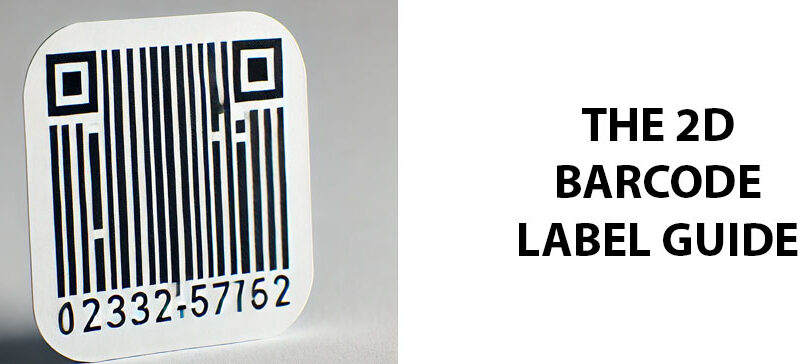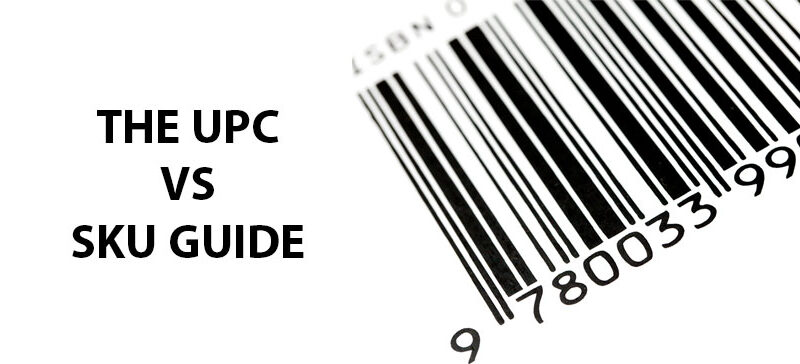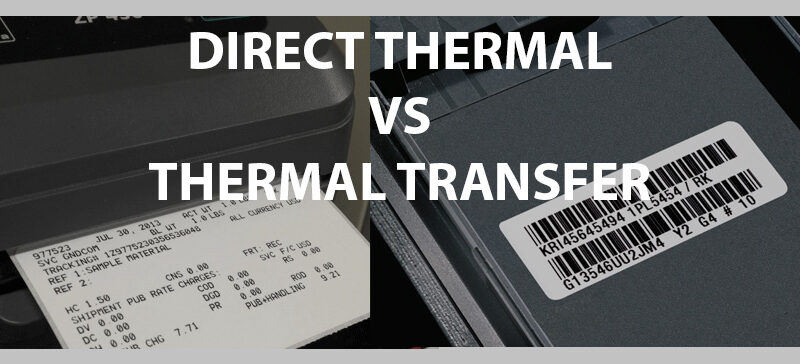2D barcode labels have grown in popularity for businesses in every industry. If you’ve never used 2D barcodes, you might be wondering what they are. But chances are, you’ve interacted with a QR code in a retail setting or maybe scanned a ticket that uses PDF417. These 2D barcode labels encode tons more information than traditional 1D barcodes and can be used in tons of different applications.
If you’re looking to learn more about these versatile barcodes, we’ve got you covered. In this guide, we’ll talk about what 2D barcode labels are, the types of 2D barcodes, their best uses and applications, and how to make them.
What Are 2D Barcode Labels?
A 2D barcode label uses a two-dimensional barcode that encodes information horizontally and vertically. In comparison, traditional 1D (one-dimensional) barcodes only encode information horizontally. Because 2D barcode labels use both axes, they hold up to 7,089 characters, which is much more information than a standard barcode. There are several different types of 2D barcodes, but some of the most common include QR codes, Data Matrix, PDF417, and Aztec.
Some of the characteristics of a 2D barcode label include:
- Higher data capacity: 2D barcodes can store tons more data than 1D barcodes in a small space.
- Error correction: Most 2D barcodes include error correction so they can still be scanned if part of the barcode is damaged.
- Data types: 2D barcodes can store different types of data, including URLs, contact information, product details, serial numbers, and more. This makes them extremely versatile.
- Scanning: 2D barcode labels require image-based scanners, like a camera-based system, to read the encoded data. Most smartphones can scan a 2D barcode label.
Types of 2D Barcode Labels
There are several different types of 2D barcode labels today. Some of the most common types of 2D barcode labels include:
- QR (Quick Response) Code: QR code labels are used in tons of applications from marketing and contract information to payments and ticketing. You’ve likely seen them in use in your day-to-day life. QR codes use a square grid with black modules on a white background to store up to 7,089 characters. They can store URLs, text, contact details, and more.
- Data Matrix: Commonly used in industrial, healthcare, and logistics applications, Data Matrix barcodes have a high data density and can be made very small. They use a square or rectangular black and white grid to store up to 3116 numeric characters.
- PDF417: PDF417 barcodes use a series of linear barcodes stacked on top of one another to encode over 1,800 characters. They are often used for boarding passes, shipping labels, identification cards, and inventory management.
- Aztec code: Another common 2D barcode label, Aztec barcodes use a square grid with a central finder pattern. They can store up to 3,832 characters. Aztec barcodes are very readable even when print quality is poor. They are commonly used for mobile boarding passes, healthcare, and public sector applications.
Best Applications and Uses
2D barcode labels are very versatile, which makes them popular in a number of industries. While there are dedicated 2D barcode scanners, all you need for some types is a smartphone with a camera. This makes them accessible to tons of people. Whether you’re providing customers with information about your menu or keeping track of inventory, 2D barcode labels provide an easy way to access information quickly.
Here are some of the best applications and uses of 2D barcode labels:
- Retail: Retailers use 2D barcode labels to track products and pricing, manage inventory, and more. 2D barcodes can be used on receipts to make returns easier. Customers can also scan 2D barcode labels with their smartphones to access instructions or warranty information for a new product.
- Marketing: 2D barcode labels, and QR codes in particular, have been adopted readily in the marketing sector. You can use 2D barcode labels to send customers to a landing page, promotion, video, or other advertising and marketing content.
- Healthcare: The healthcare industry relies on 2D barcode labels for accurate tracking and tracing of medication, lab samples, and medical equipment. 2D barcodes can store a large amount of information in a small space, making them very useful on pharmaceutical labels.
- Warehouses: If you’re in the warehouse and logistics industry, you’ve likely used 2D barcode labels. They’re a quick way to track parts, manage inventory, and streamline supply chains.
Because 2D barcode labels are so versatile, these are just some of the ways they can be used to encode and manage information.
How to Scan 2D Barcode Labels
One of the major benefits of 2D barcode labels is how easy they are to scan. There are specialized 2D barcode scanners, but most smartphones are also capable of scanning these types of barcodes.
If you’re using a smartphone, you can typically open your camera app and point it at the 2D barcode. A link should pop up. When you click it, you’ll be taken to the encoded information, which may be an instruction manual, menu, video, URL, or contact information.
If you’re in an industrial setting, you may have access to a dedicated 2D barcode scanner. This will be connected to a computer, tablet, or smartphone. Once you scan the barcode, the information will be decoded and transmitted to the connected system.
For best results, you’ll want to follow these steps to scan a 2D barcode label:
- Make sure you have enough lighting for the scanner to capture the barcode.
- Hold the scanning device steady, and keep the barcode in focus.
- Align the barcode within the scanning frame or focus area of the camera. Because of the way 2D barcodes are created, you usually don’t need to worry about orienting your scanner in a particular way.
- If the scanner is having a hard time reading the barcode, make sure the barcode is clean and undamaged.
When Not to Use
While 2D barcode labels have tons of uses and benefits, they won’t always be the right choice. Here are some circumstances when you may want to choose a different type of barcode label:
- Limited data needs: If your application only requires a small amount of data, such as a simple code, a traditional 1D barcode is probably a more cost-effective option.
- Budget concerns: To start using 2D barcode labels, you’ll typically need to invest in printers and scanners. If you don’t have the budget for this yet, you may be better off sticking with 1D barcodes.
- Industry standards: Some industries have established standards that favor 1D barcodes. If you need to stay compliant with these standards, it’s better to stick with 1D barcode labels.
How to Know Which Type is Best for You
If you’ve never used a 2D barcode label before, you may be unsure what type is best for you. Each format has specific strengths, so you’ll want to find the one that works best for your circumstances. Here are some factors you might take into consideration:
- Data size: One of the first things to consider is how much data you need to encode. QR Codes and Data Matrix, for example, can encode a ton of data, while Micro QR Codes and Maxi Code can contain much less data.
- Space constraints: Next, you’ll want to think about how much physical space your 2D barcode label will need. Data Matix, Micro QR Codes, and Aztec are all types that fit in tight spaces.
- Scanning environment: Consider who will be scanning the labels. QR codes work well with smartphones, which is why they’re so beneficial for marketing and advertising. On the other hand, PDF417 can be scanned from a distance and from various angles, making them a good choice for ID cards and boarding passes.
- Industry standards: Certain industries rely on specific 2D barcode formats. For example, the healthcare industry often relies on Data Matrix while the logistics industry uses MaxiCode for tracking packages.
How to Make 2D Barcode Labels
Creating 2D barcode labels is a fairly simple process that requires a few steps. After you’ve determined which type of 2D barcode is right for you, you can follow these steps:
- Decide which information to encode.
- Determine the size of the label and any other information it might need.
- Use an online generator or software to generate your 2D barcodes.
- Design the 2D barcode label with the generated barcode.
- Print your labels.
- Test the barcodes for accuracy.
At Coast Label, we understand how important it is for 2D barcode labels to be durable and scannable. We use only the best materials to manufacture custom labels to meet your unique needs. Contact us today for a proposal!



